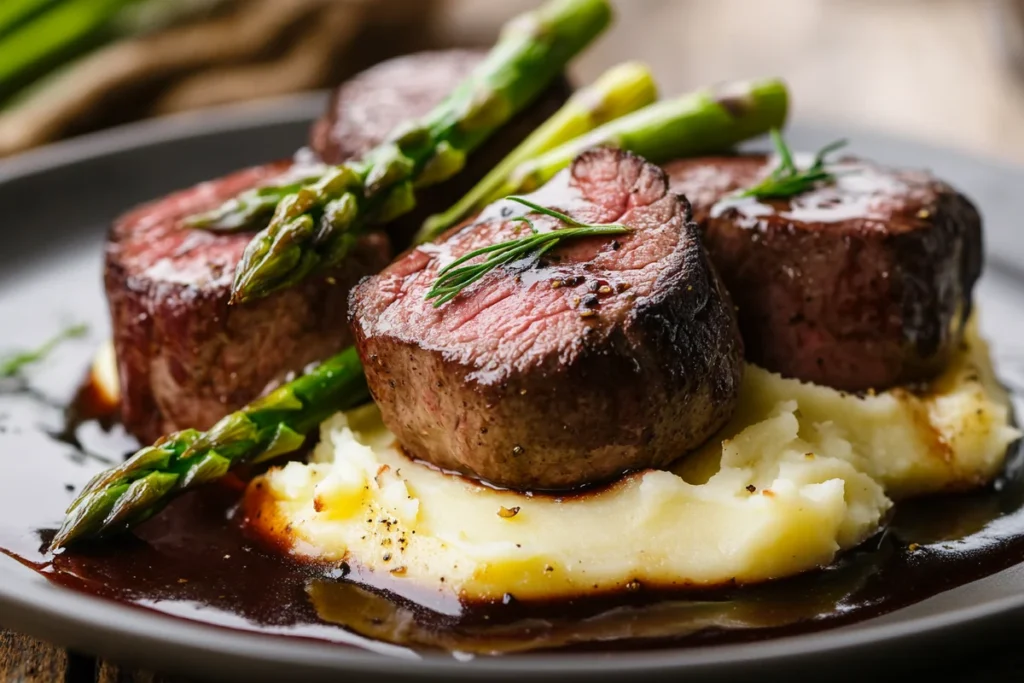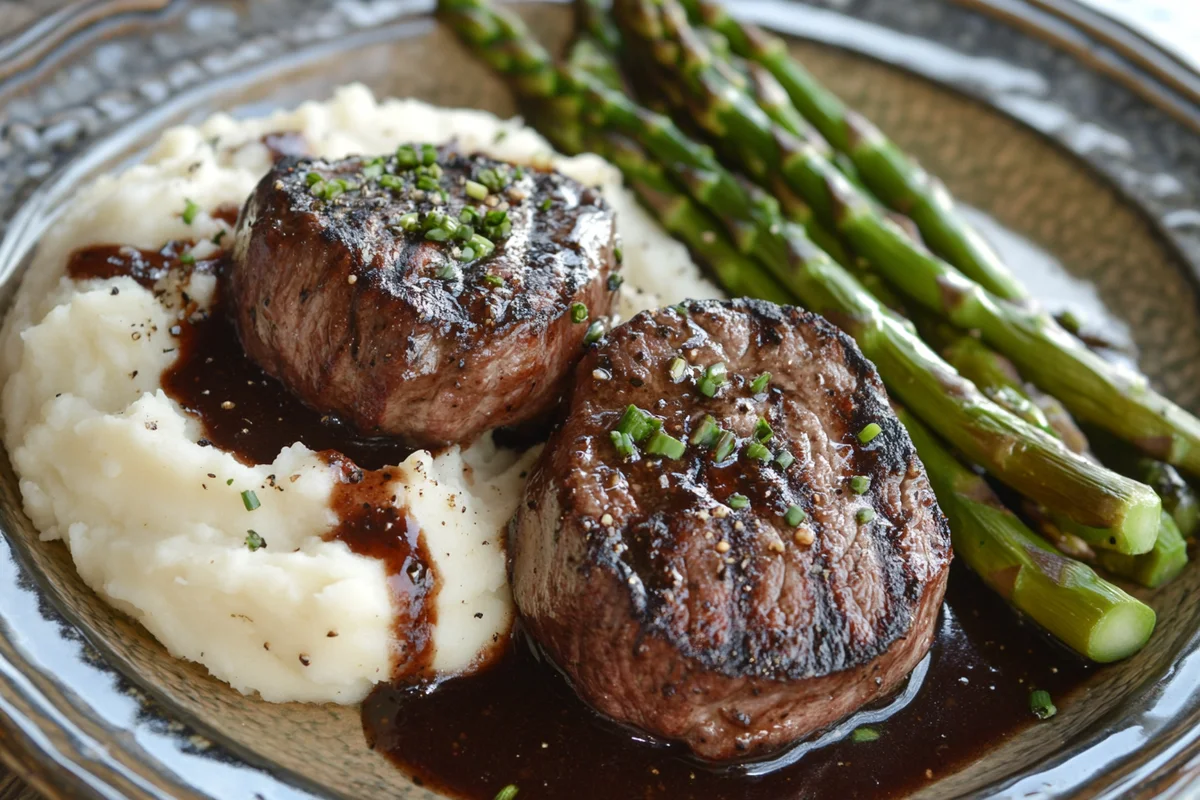Succulent beef tenderloin medallions are a delightful and versatile dish. This guide explores how to prepare them perfectly for any occasion.
What Are Beef Tenderloin Medallions?
Beef tenderloin medallions are small, round cuts from the tenderloin of beef. Therefore, they’re known for their tenderness and mild flavor. Furthermore, their small size allows for quick cooking, making them a great choice for weeknight meals or elegant dinners.
Why Choose Beef Tenderloin?
Beef tenderloin is the most tender cut of beef. In addition, it is very lean. Moreover, beef tenderloin medallions offer a premium eating experience. Therefore, they are perfect for special occasions. They’re also easy to cook, so home cooks can master them.
How to Prepare Beef Tenderloin Medallions
Preparing beef tenderloin medallions is simple. However, the key is to use the right cooking method. Also, use the right seasoning. Let’s explore the best techniques for perfect medallions.
Selecting Your Beef Tenderloin
When selecting beef tenderloin for medallions, look for good marbling. In other words, select beef with flecks of fat within the muscle. Consequently, this marbling adds flavor and moisture during cooking. Additionally, choose tenderloin that is firm to the touch. Furthermore, it should have a bright red color.
Cutting the Medallions
To cut medallions, first, trim any silver skin or excess fat from the tenderloin. Next, slice the tenderloin into rounds that are about 1 to 1.5 inches thick. These rounds are your beef tenderloin medallions. Finally, gently flatten them with the palm of your hand.
Seasoning Your Medallions
Simple seasoning is best for beef tenderloin medallions. For example, use salt, black pepper, and garlic powder. However, you can also use herbs like thyme or rosemary. A simple marinade of olive oil, lemon juice, and herbs can enhance the flavor. Remember to season the medallions generously on both sides.
Cooking Methods for Beef Tenderloin Medallions
Several cooking methods work well for beef tenderloin medallions. However, pan-searing and grilling are the most popular. Additionally, broiling and oven-roasting are also viable options.
Pan-Searing Beef Tenderloin Medallions
Pan-searing is a fast and effective way to cook beef tenderloin medallions. Here’s how:
- Heat: Heat a heavy-bottomed skillet, and cast iron pan, over medium-high heat.
- Add Oil: Add about one tablespoon of oil with a high smoke point, such as avocado oil.
- Sear: Sear the beef tenderloin medallions for 2-3 minutes per side. Above all, sear them until they develop a nice brown crust.
- Check Temperature: Use a meat thermometer to check the internal temperature.
- Rest: Let the medallions rest for a few minutes before serving. This allows the juices to be redistributed.
Grilling Beef Tenderloin Medallions
Grilling adds a smoky flavor to beef tenderloin medallions. Follow these steps:
- Preheat: Preheat your grill to medium-high heat.
- Oil Grates: Oil the grill grates to prevent sticking.
- Grill: Grill the beef tenderloin medallions for 2-4 minutes per side. In other words, grill them until they reach your desired doneness.
- Rest: Let the medallions rest for a few minutes before serving.
Broiling Beef Tenderloin Medallions
Broiling is another quick method. Place the beef tenderloin on a broiling pan. However, keep them a few inches from the heat source. Broil for 3-5 minutes per side, depending on thickness and desired doneness.
Oven-Roasting Beef Tenderloin Medallions
Oven roasting is ideal for cooking larger batches. Sear the beef tenderloin medallions in a hot skillet first. Then, transfer them to a roasting pan and roast in a preheated oven at 400°F (200°C) for 8-12 minutes. Consequently, this depends on the desired doneness.
Achieving Perfect Doneness
Knowing the internal temperature is essential for perfect beef tenderloin. Use a meat thermometer to ensure accurate results. Here are some guidelines:
- Rare: 125-130°F (52-54°C)
- Medium Rare: 130-140°F (54-60°C)
- Medium: 140-150°F (60-66°C)
- Medium Well: 150-160°F (66-71°C)
- Well Done: 160°F (71°C) and above
Beef tenderloin medallions are best served at medium-rare or medium. Therefore, this ensures they remain tender and juicy.

Creative Beef Tenderloin Medallions Recipes
Beef tenderloin medallions are incredibly versatile. Consequently, they lend themselves to a wide variety of recipes. Here are a few ideas to inspire you:
Beef Tenderloin Medallions with Red Wine Sauce
A classic combination is beef tenderloin medallions with red wine sauce. For example, create a rich sauce using red wine, beef broth, shallots, and butter. Pour the sauce over the medallions for a sophisticated dish.
Beef Tenderloin Medallions with Mushroom Gravy
Beef tenderloin medallions with mushroom gravy offer an earthy and savory flavor profile. Sauté mushrooms with garlic and thyme, then add beef broth and cream to create a creamy gravy.
Beef Tenderloin Medallions with Garlic Herb Butter
For a simple yet flavorful option, top your beef tenderloin medallions with garlic herb butter. Combine softened butter with minced garlic, chopped herbs (such as parsley and chives), and a pinch of salt.
Beef Tenderloin Medallions with Balsamic Glaze
Drizzle beef tenderloin medallions with balsamic glaze for a sweet and tangy contrast. Reduce balsamic vinegar in a saucepan until it thickens into a syrupy glaze.
Perfect Beef Tenderloin Medallions Pairings
Choosing the right sides can elevate your beef tenderloin medallions meal. Here are a few suggestions:
Classic Side Dishes
- Mashed Potatoes: Creamy mashed potatoes are a classic pairing.
- Roasted Asparagus: Roasted asparagus with olive oil and sea salt is simple. In addition, it is elegant.
- Green Beans: Sautéed green beans with garlic and almonds are crunchy and delicious.
Elegant Side Dish Options
- Scalloped Potatoes: Scalloped potatoes are rich and creamy. They are perfect for a special occasion.
- Creamed Spinach: Creamed spinach has a lush and comforting side.
- Wild Rice Pilaf: Wild rice pilaf adds texture and nutty flavor.
Salad Options
- Caesar Salad: A crisp Caesar salad provides a refreshing contrast.
- Arugula Salad: Arugula salad with shaved Parmesan and lemon vinaigrette is peppery and bright.
Tips for the Best Beef Tenderloin Medallions
- Pat Dry: Pat the beef tenderloin medallions dry with paper towels before cooking. This helps them brown better.
- Hot Pan: Ensure your pan is hot before adding the medallions.
- Don’t Overcrowd: Avoid overcrowding the pan, as this lowers the temperature and prevents browning.
- Rest: Allow the medallions to rest after cooking. In other words, let them rest for at least 5 minutes before slicing and serving.
Storing and Reheating Beef Tenderloin Medallions
Store leftover beef tenderloin in an airtight container in the refrigerator for up to 3 days. To reheat, gently warm them in a skillet over low heat or the oven at 300°F (150°C). Avoid overheating, as this can dry them out.
Beef Tenderloin Medallions Health Considerations
Beef tenderloin is leaner compared to other cuts of beef. However, portion control is important. Therefore, combine it with plenty of vegetables and whole grains for a balanced meal.

Exploring Different Sauces for Beef Tenderloin Medallions
The right sauce can transform your beef tenderloin medallions from simple to spectacular. Therefore, let’s delve deeper into sauce options, exploring flavors that perfectly complement the delicate beef.
Creamy Horseradish Sauce
A creamy horseradish sauce provides a zesty counterpoint to the richness of the beef tenderloin. For instance, combine horseradish, sour cream, mayonnaise, lemon juice, and a touch of sugar for a balanced flavor. In addition, this sauce pairs beautifully with the tenderness of the beef.
Bearnaise Sauce
Bernaise sauce is a classic French sauce that elevates beef tenderloin. For example, this rich sauce is made with clarified butter, egg yolks, tarragon, shallots, and vinegar. It’s creamy, tangy, and herbaceous, and enhances the overall flavor.
Chimichurri Sauce
For a fresh and vibrant option, serve your beef tenderloin with chimichurri sauce. This Argentinian sauce is made with parsley, garlic, olive oil, red wine vinegar, oregano, and red pepper flakes. Consequently, it adds a burst of flavor that cuts through the richness of the beef.
Peppercorn Sauce
Peppercorn sauce is a bold and flavorful choice. Sauté cracked peppercorns with shallots, deglaze the pan with cognac, and add beef broth and cream to create a rich, peppery sauce.
Mastering the Art of Searing Beef Tenderloin Medallions
Searing is crucial for achieving the best flavor and texture in beef tenderloin. Therefore, let’s explore some advanced techniques to master this cooking method.
Achieving a Perfect Crust
- Pat Dry: Always pat the beef tenderloin medallions completely dry with paper towels. Therefore, removing surface moisture promotes browning.
- High Heat: Use high heat to quickly sear the medallions. However, be careful not to burn them.
- Don’t Overcrowd: Sear the medallions in batches. Avoid overcrowding the pan.
- Use the Right Oil: Select an oil with a high smoke point, such as avocado oil, grapeseed oil, or refined coconut oil.
- Let it Rest: Allow the beef tenderloin medallions to rest in the hot pan for a few minutes after searing. This helps to seal the juices.
Controlling the Internal Temperature
- Use a Thermometer: Invest in a good quality meat thermometer. Monitor the internal temperature to avoid overcooking.
- Pull Early: Remove the beef tenderloin from the heat when they are a few degrees below your desired temperature. They will continue to cook as they rest.
- Resting is Key: Letting the medallions rest is critical. This allows the juices to redistribute, resulting in more tender and flavorful meat.
Adding a Personal Touch: Flavor Infusions for Beef Tenderloin Medallions
Infusing flavor into your beef tenderloin can elevate them to a whole new level. Therefore, let’s explore some creative ways to add unique flavors.
Herb-Infused Oil
Create an herb-infused oil by heating olive oil with fresh herbs such as rosemary, thyme, and garlic. Let the oil cool, then use it to sear the beef tenderloin. Consequently, this imparts a subtle yet complex flavor.
Garlic Butter Basting
Basting the beef tenderloin medallions with garlic butter during the last few minutes of cooking adds a rich and savory flavor. For example, combine melted butter with minced garlic, chopped parsley, and a pinch of salt.
Wine Reduction
Deglaze the pan with red wine or white wine after searing the beef tenderloin. Let the wine reduce to a syrupy consistency. Then, pour it over the medallions for a rich and flavorful sauce.
Spice Rubs
Experiment with different spice rubs to add warmth and depth to your beef tenderloin. For example, combine smoked paprika, chili powder, cumin, garlic powder, onion powder, and brown sugar for a southwestern-inspired flavor.
Plating and Presentation: Making Beef Tenderloin Medallions Visually Appealing
Presentation is key to enhancing the overall dining experience. Therefore, let’s explore some tips for plating and appealingly presenting your beef tenderloin medallions.
Thoughtful Arrangement
Arrange the beef tenderloin medallions artfully on the plate. Consider stacking them slightly or fanning them out.
Sauce Placement
Drizzle the sauce strategically over the medallions. Avoid smothering the entire plate. Instead, create pools of sauce that complement the arrangement.
Garnish with Fresh Herbs
Garnish the plate with fresh herbs such as parsley, chives, or rosemary. This adds a pop of color and freshness.
Add a Contrasting Element
Include a contrasting element to add visual interest. For example, sprinkle the plate with sea salt flakes, red pepper flakes, or toasted nuts.
Keep it Clean
Wipe the edges of the plate clean to create a polished and professional look.
Advanced Cooking Techniques for Beef Tenderloin Medallions
Beyond basic searing and grilling, several advanced cooking techniques can take your beef tenderloin medallions to the next level.
Sous Vide
Sous vide is a method of cooking food in a water bath at a precise temperature. This ensures even cooking and maximum tenderness. Cook the beef tenderloin medallions sous vide, then quickly sear them in a hot pan to develop a crust.
Reverse Sear
The reverse sear involves slow-roasting the beef tenderloin medallions in the oven at a low temperature, then searing them in a hot pan to finish. This creates a perfectly cooked interior and a crisp exterior.
Smoking
Smoking beef tenderloin medallions adds a unique smoky flavor. Use a smoker or a grill with wood chips to smoke the medallions at a low temperature before searing them.
Conclusion: Enjoy Your Beef Tenderloin Medallions
Beef tenderloin medallions are an excellent choice for a delicious and elegant meal. With the right techniques and pairings, you can create a memorable dish that everyone will love. Whether you pan-sear, grill, or roast them, enjoy the tenderness and flavor of these exquisite cuts of beef.

Frequently Asked Questions (FAQs)
What goes well with grilled salmon?
While the topic is beef tenderloin medallions, grilled salmon compliments several dishes. These pairings include:
- Roasted vegetables: Such as asparagus, bell peppers, and zucchini.
- Salads: A crisp garden salad with a light vinaigrette.
- Grains: Quinoa, rice, or couscous seasoned with herbs and lemon.
Is grilled salmon healthy for weight loss?
Grilled salmon can be healthy for weight loss. Moreover, it is rich in omega-3 fatty acids and protein. It also helps you feel full. But watch the portion sizes.
How much is the grilled salmon salad from Texas Roadhouse?
This information may vary. However, check with your local Texas Roadhouse for the most accurate pricing. Additionally, menu prices can change.
What does Gordon Ramsay serve with salmon?
Gordon Ramsay often serves salmon with simple, flavorful sides. This often includes:
- Asparagus
- New potatoes
- Lemon butter sauce

